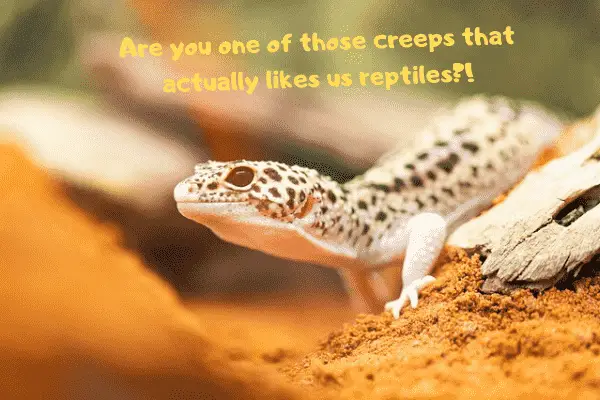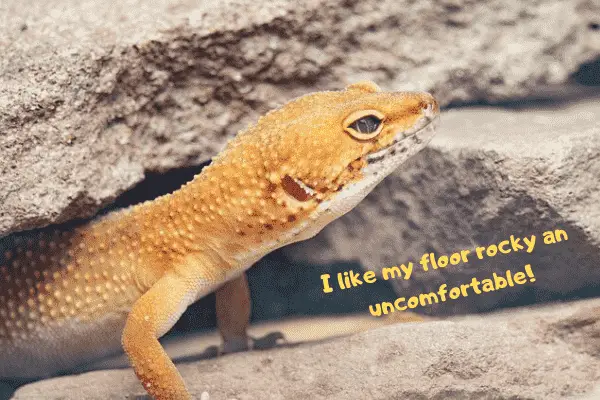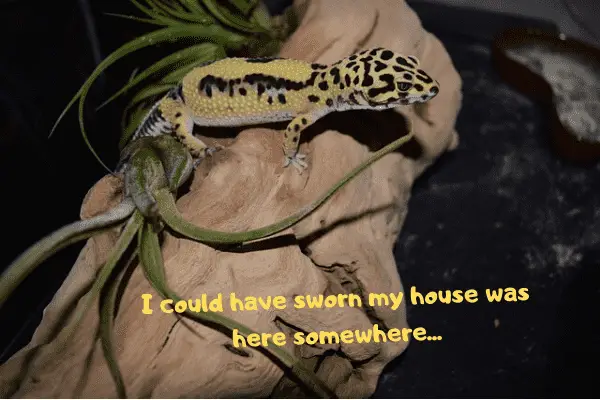Leopard geckos… They make for great pets and are a favorite among reptile keepers. Even though there are still people who think all reptiles are slimy and live in their dark lairs waiting for the next person they can eat, most reptiles are quite cute once you get to know them.
This post is about leopard gecko’s habitat, where they live and how they should be kept in captivity. Let’s get into the article!

In the wild, a leopard geckos’ habitat is rocky and warm. They live in areas around India and Afghanistan in the wild, and it’s our job as reptile keepers to give them a good environment to live in that matches where they frequent in the wild.
When designing your leopard gecko terrarium, there are a few things you need to keep in mind. We’ve just created this post in a question and answer style, but if there’s anything we’ve forgotten then please let us know!
Want to learn more about leopard gecko care? Check out our leopard gecko care guide for the full scoop!
We’re always looking to improve our recourses so it would be much appreciated!
Now, let’s get into what your leopard gecko’s habitat should look like and how you can create a good enclosure for your leopard gecko!
Table of Contents
How large should a leopard gecko enclosure be?
A leopard gecko’s enclosure should be at least 10-20 gallons, but the more the better. This will ensure it has enough space to move around and thermoregulate. The more area you give to your leopard gecko, the more natural behavior you can enjoy watching.
If you are using heat lamps to heat the enclosure, then you will need a terrarium larger than 20 gallons to prevent it from over-heating. Exactly how large is hard to say as I don’t have experience housing leopard geckos using overhead lights. It’s best practice to use a heat mat as in the wild they get their heat from the floor in the evenings anyway, not from direct sunlight.
The rule of thumb is that your gecko needs a good amount of colder space in order to be able to reach the right body temperature. Heat about one-third of the enclosure, and leave the rest without a heat mat to allow them to choose the temperature that they want.
Tip: Don’t place the water bowl on the heat mat as it will cause the glass to steam up. If you need to raise the humidity, then placing a small part of the bowl on the heat mat is usually more than enough.
A larger enclosure will make it easier for you to regulate humidity and also prevents you from running out of space on either the hot side or the cold side.

What’s the best type of terrarium for a leopard gecko?
When buying a leopard gecko terrarium, there are a few things you can do to make sure it’s going to be the most comfortable home possible for your new pet.
First, make sure it’s made with thick and durable glass. Not only will you be adding substrate on the floor, but you may also add some rocks and hides too.
As you can tell, this can get heavy quite quickly and the bottom of your terrarium breaking is not good news for you or your new pet!
Another thing to keep in mind is that terrariums that open from the side are best for housing leopard geckos. This not only makes it easier for you to access everything to clean, but it also makes it a much better experience for your Leo.
Leopard geckos are small animals and a lot of their predators come from above. From my experience, most reptiles prefer you coming in from the side. Even though there’s no risk of them harming you, they could get stressed out which is bad for your gecko.
A leopard gecko’s terrarium really shouldn’t be any smaller than 20 gallons, but the larger the better. This gives them more room to move around in and also makes it easier for you to manage the temperature and humidity.
Find out more on leopard gecko temperature and humidity in this post!
What substrate should I use for a leopard gecko?
The topic of substrate is debated about fiercely among reptile keepers. Some swear by sand while others say that it causes death among a lot of reptiles.
While your leopard gecko is still young, it’s best to keep them on paper towels or newspaper. This is more sanitary for them and makes cleaning easy for you.
As they get old, it’s fine to use a specially designed sand substrate. Bear in mind this is from my own experience, and if you’re worried about your leopard gecko eating too much of the sand, keep them on paper towels or newspapers.
If you do go for sand and notice your leo eating it way too often, change the substrate… Even though they’re “just lizards,” these cute little leos still vary in character.
It’s thought that leopard geckos eat the sand as a form of calcium, but this hasn’t been confirmed. There are also calcium enriched sands that serve this exact purpose, but again, it’s debated whether or not this is good or bad for them.
Just ensure that your leo gets enough calcium, and try to feed them in a special feeding dish or somewhere away from the sand. This will prevent them eating any excess sand.
If you feel that paper towels or newspapers would be better, then go with that!
These options do have the advantage that they’re very easy to clean.
If you want the best of both worlds, reptile carpets are a great option for you. This gets rid of the awful sight of a paper towel floor and prevents any possible complications due to sand.
Top tip: Beware that your leo’s nails don’t get too long! If they get stuck to the reptile carpet, this could result in missing toes.
How often to clean your leopard gecko’s enclosure?
This depends on the type of substrate you use, but as a general rule, try to remove any dirty parts whenever you can. Spot cleaning prevents any toxins from building up and also helps to prevent foul smells from leaking out into the room.
On top of this, you should completely clean paper towel or reptile carpet once or twice a week. If you use a sand substrate it’s best to clean the entire tank at least every two weeks since spot cleaning urine is a lot easier on sand.
Also, make sure to take any dirt or faeces out of the water bowl as soon as you can and refresh the water. Any build up of ammonia in the water can cause major problems for your gecko. This is also true for any dead insects.
Dead insects should always be removed from the enclosure, as your leo isn’t going to eat them anyway. When they start to rot they stink and also release ammonia which can be harmful to your leo.

What shelters to use for leopard geckos
Shelters are very important to your leopard gecko. When recreating a leopard gecko habitat, it’s important to provide them with enough places to hide out in.
Leopard geckos usually spend the majority of their day in rocky crevasses, so shelters are going to be its best friend.
Most reptile shelters are fine to serve this purpose. After a while and a little experimentation you will see which shelters are its favorite.
Tip: Make sure the shelters can’t fall over. This can cause injury to your leopard gecko and should definitely be avoided. Most reptile hides are built to ensure safe use, but make sure to keep an eye on this when placing them in the enclosure.
The same goes for pieces of wood or plants you may choose to add to the leopard gecko enclosure.
What can I add to leopard gecko enclosure?
You can add pretty much anything that’s non-toxic to a leopard gecko enclosure. Try to create the best habitat for your leopard gecko to ensure it stays healthy. This includes shelters, a water bowl and some enrichment.
Things like plants and wood can provide a naturalistic look, all while giving your Leo a space to
Make sure that anything you place into the terrarium is free of any other lifeforms. This prevents you from introducing pests or illnesses from outside to the enclosure.
Don’t add wood that you’ve found lying around somewhere as this could cause problems for your leopard gecko. Wood can be treated though, so if you like DIY projects, check out this YouTube video that shows you how!
Another thing to be aware of is splintering. Try to ensure that any wood you do place into the terrarium to smooth and won’t cut or splinter your gecko. It’s best to go with hardwood too, not softer wood sorts or ones that leak sap.
What plants can I use in leopard gecko enclosure?
When it comes to plants in a leopard gecko enclosure, fake makes things way easier. Creating whole naturalistic terrariums may sound great, but when you need to add lighting for the plants and think about cleaning it, things get a lot less appealing.
There are lots of options when it comes to fake plants, and any reptile store or generalist online store should have suitable options.
Just as with the wood, ensure that they are free from external lifeforms and won’t cut or injure your gecko.
To summarize
As you can see, there’s a lot more to a leopard gecko enclosure than just pouring some sand into a pot and adding your leo!
Hopefully, after reading this article, you’re in a much better position to create the perfect leopard gecko habitat.
If you have any questions or there’s anything that I’ve missed, please leave a comment. We’re always looking to improve our recourses and any feedback or questions are much appreciated!

